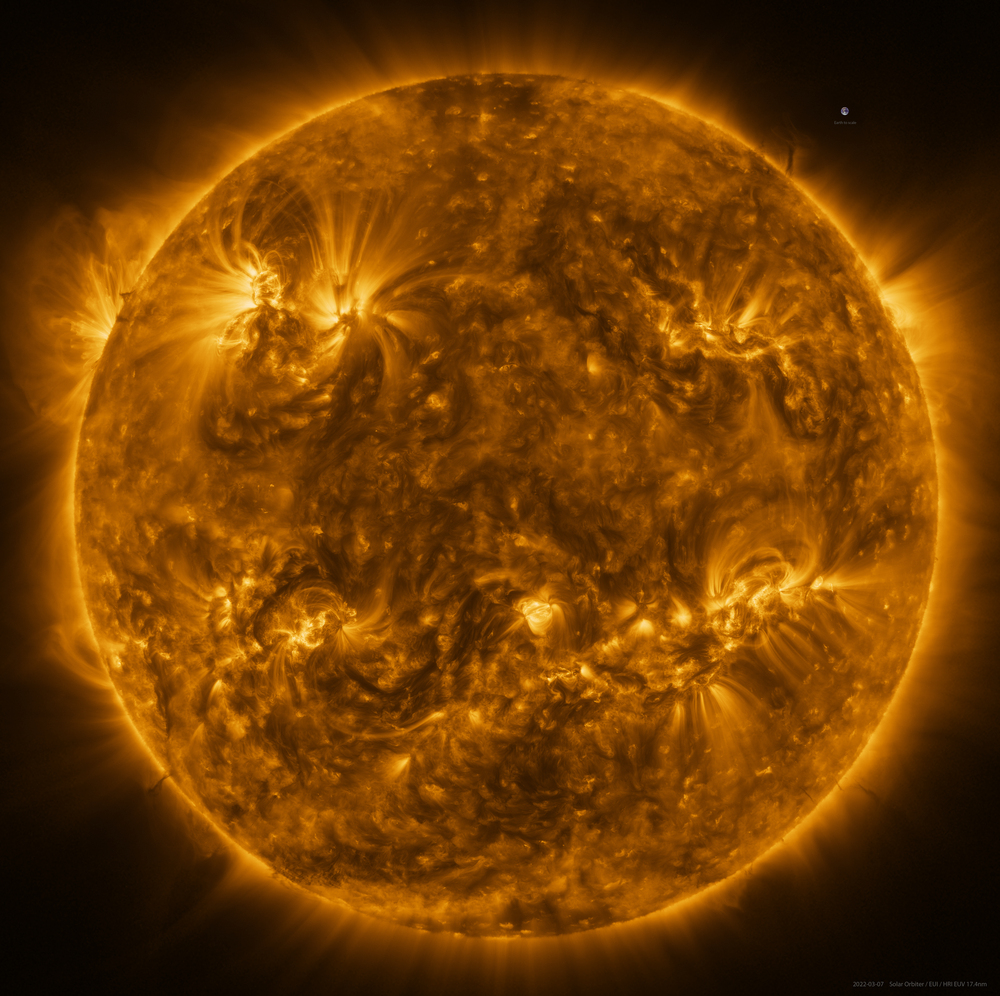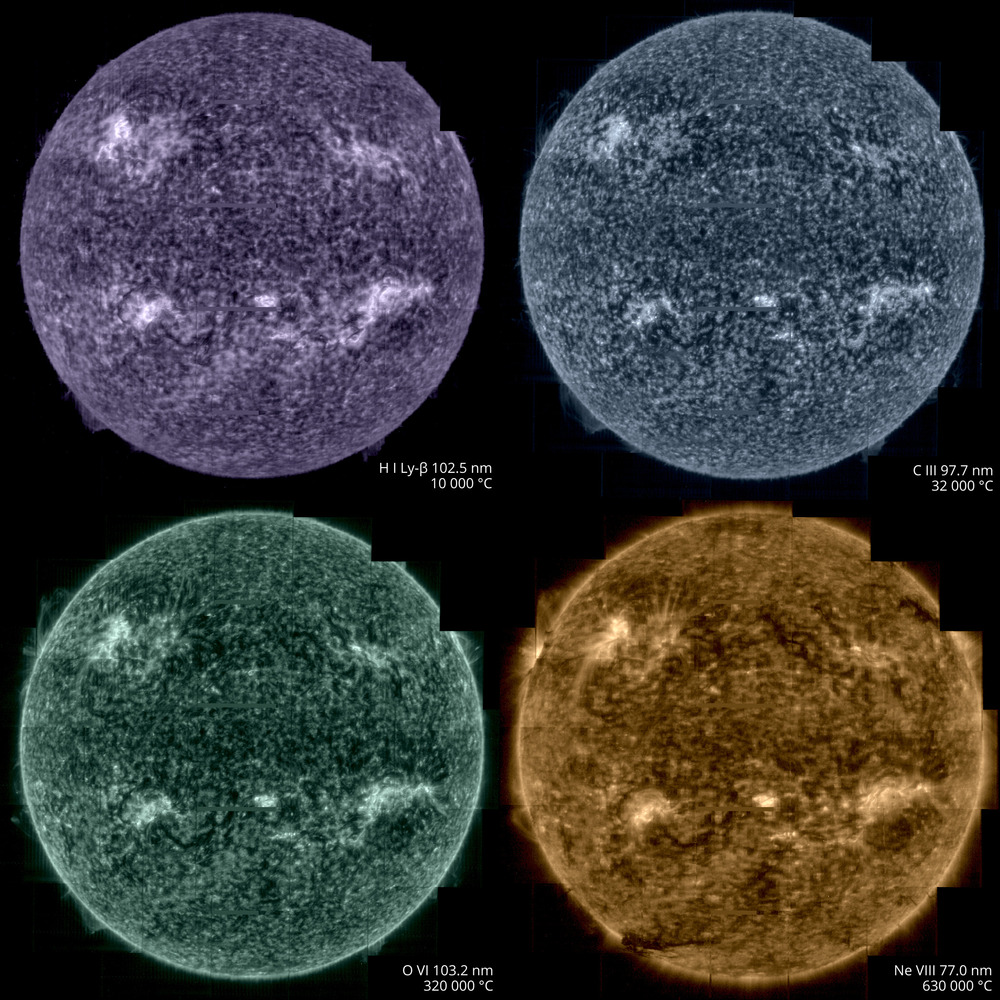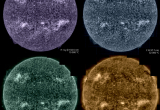Zooming into the Sun with Solar Orbiter
Solar Orbiter’s latest images shows the full Sun in unprecedented detail. They were taken on 7 March, at a distance of roughly 75 million kilometres, half way between the Earth and Sun. One of the images, taken by the Extreme Ultraviolet Imager (EUI) is the highest resolution image of the Sun’s full disc and outer atmosphere, the corona, ever taken. Another image, taken by the Spectral Imaging of the Coronal Environment (SPICE) instrument, represents the first full Sun image of its kind in 50 years, and by far the best one, taken at the Lyman-beta wavelength of ultraviolet light that is emitted by hydrogen gas.
EUI images the Sun in the extreme ultraviolet region of the electromagnetic spectrum. IAS, co-Principal Investigator of EUI, was instrumental in providing the mirrors and subsystems of its telescopes. Those reveal the Sun’s upper atmosphere, the corona, which has a temperature of around a million degrees Celsius. The high-resolution telescope of EUI takes pictures of such high spatial resolution that, at that close distance, a mosaic of 25 individual images is needed to cover the entire Sun. Taken one after the other, the full image was captured over a period of more than four hours. In total, the final image contains more than 83 million pixels in a 9148 x 9112 pixel grid. For comparison, this image has a resolution that is ten times better than what a 4K TV screen can display. “The individual images, obtained on 7 March at a distance of 0.5 astronomical units, are already among the most resolved ever obtained of the solar corona. The probe is now moving to 0.32 astronomical units, and the images obtained show even finer structures! The mirrors of the instrument were made jointly by Institut d'Astrophysique Spatiale and Institut d'Optique. Their surface never deviates more than 5 nm from the ideal shape, which makes it possible to obtain these fantastic images.“, says Frédéric Auchère, co-PI of the EUI instrument.

EUI image (zoomable version; guided tour in video).
The Sun in high resolution (zoomable version),
At the 2 o’clock (near the image of the Earth for scale) and 8 o’clock positions on the edges of the Sun, dark filaments can be seen projecting away from the surface. These ‘prominences’ are prone to erupt, throwing huge quantities of coronal gas into space and creating ‘space weather’ storms.
Credit: ESA & NASA/Solar Orbiter/EUI team; Data processing: Emil Kraaikamp (ROB).
SPICE is designed to trace the layers in the Sun’s atmosphere from the corona, down to a layer known as the chromosphere, closer to the surface. The instrument does this by looking at the different wavelengths of extreme ultraviolet light that come from different atoms. IAS, which provided the grating assembly of the SPICE optical system, leads the scientific operations of the instrument.
In the SPICE sequence of images, purple corresponds to hydrogen gas at a temperature of 10 000°C, blue to carbon at 32 000°C, green to oxygen at 320 000°C, yellow to neon at 630 000°C. The image is composed of 750 images that were taken over 25 pointings, assembled by Gabriel Pelouze (IAS), who says: “It is a painstaking process to glue these small images back together. But the result is worth it: we obtain maps of specific chemical elements, at a given temperature. This is the biggest asset of spectroscopy: we obtain much more information than by making mere images.”
This will allow solar physicists to trace the extraordinarily powerful eruptions that take place in the corona down through the lower atmospheric layers. It will also allow them to study one of the most puzzling observations about the Sun: how the temperature is rising through the ascending atmospheric layers, a mysterious phenomenon that is also one of the key scientific objectives of Solar Orbiter.

Taking the Sun’s temperature (animation)
SPICE takes simultaneous “spectral images” at several different wavelengths of the extreme ultraviolet spectrum by scanning its spectrometer slit across a region on the Sun. The different wavelengths recorded correspond to different layers in the Sun’s lower atmosphere. Purple corresponds to hydrogen gas at a temperature of 10 000°C, blue to carbon at 32 000°C, green to oxygen at 320 000°C, yellow to neon at 630 000°C.
Credit: ESA & NASA/Solar Orbiter/SPICE team; Data processing: Gabriel Pelouze (IAS).
On 26 March, Solar Orbiter reaches another mission milestone: its first close perihelion. The spacecraft is now inside the orbit of Mercury, the inner planet, taking the highest resolution images of the Sun it can take.
And this is just the start, over the coming years the spacecraft will repeatedly fly this close to the Sun. It will also gradually raise its orientation to view the Sun’s previously unobserved polar regions.
Contacts at IAS: Frédéric Auchère, Gabriel Pelouze
Links:
- ESA press release
- Video (Institut d'Optique): how the EUI mirrors have been made




